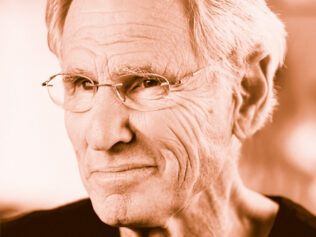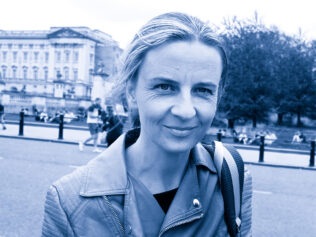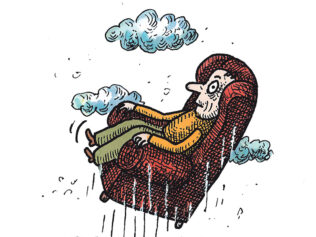
Optimists live longer, are more self-confident, and deal with stress more effectively. Pessimists can also learn to be optimistic, and here’s some advice on how to do it.
It was in the late 1960s when American psychologist Martin Seligman started research that would soon make him famous in the scientific community. His goal was to analyze the mechanism behind learned helplessness, which is a state of passivity and resignation resulting from a belief that, no matter what actions we take, they won’t have any impact on what happens to us. In his laboratory experiments, Seligman managed to generate a sense of helplessness: first in dogs, then in mice, rats, and pigeons. It became more challenging, however, when he began to research people. As he recalled in a 2020 American NPR program dedicated to optimism, “One-third of people I could not make helpless in laboratory, so I began to wonder, what was it about some people that makes them so resilient?”
The subject of the program was not accidental. As Alix Spiegel, a science journalist who hosted it, observed, “Seligman came to research on optimism through a strange back door.” He demonstrated that people who had an optimistic approach to life proved resistant to his experiments.
High Spirits Help
Science shows that an optimistic approach has many advantages. Optimists are more confident, persistent, and enthusiastic about life (and expect more from it). They deal with failures better than pessimists and tend to blame themselves less often, identifying unfavorable circumstances as the reason. As demonstrated in a 2001 study by Margaret Marshall and Jonathon Brown from the University of Washington, students whose levels of optimism are higher tend to claim their success (“I passed the exam because I’m gifted”) and attribute failures to external factors (“I failed because the professor picked on me”). Pessimistic students do the opposite: they blame themselves for failure (“I didn’t pass because I’m stupid”) and attribute success to a chance event (“I was just lucky”). “Known in psychology as a “bias in the service of the ego,” this way of explaining reality allows us to maintain positive self-esteem,” according to psychologist Dr. Aneta Kiwnik-Dahm from Warsaw’s SWPS University of Social Sciences and Humanities. If we are to trust the studies, optimists enjoy better health, are less prone to chronic diseases, and live longer, which was confirmed by 2019 research led by psychiatry professor Lewina O. Lee from Boston University School of Medicine. Researchers analyzed data obtained from two large-scale experiments conducted in the United States over thirty years. They found out that the greatest optimists live up to 15 percent longer than their pessimistic friends and are 1.5 times more likely to live up to the age of 85. In the case of men, these figures are respectively: 10.9 percent and 1.7 times. According to experts, this might be caused by the fact that an optimistic attitude more often leads to health-promoting behaviors such as staying physically active and eating healthily. At the same time, it makes us more able to refrain from risky behaviors such as smoking cigarettes or drinking alcohol.
Optimists deal with stress more effectively, and more often set long-term goals rather than settle for instant gratification. Pessimism, by contrast, is associated with increased tension and higher levels of cortisol, which is a stress hormone. This is most likely why, as Seligman notes in his book Learned Optimism, pessimists worry about a future catastrophe even if everything is well.
The Power of Beliefs
Strongly rooted negative beliefs can hinder our ability to perceive ourselves and the world optimistically. To quote Dr. Karol Grabowski, a psychiatrist and cognitive-behavioral therapist from the Medical University of Gdańsk: “We all develop cognitive schemas—the ways of perceiving the reality around us, ourselves, and other people. These schemas have their roots in our life experiences, in what we have learned from our significant others, especially our parents, and in patterns of behavior instilled in us.” If the beliefs that govern our self-image and the image of the world are distorted—i.e., we consider ourselves weak, incompetent, or useless and negatively perceive people around us—we will start treating the world as a threatening place.
How do we change this? “The first step is to notice the moment when our thinking negatively affects our life, limiting our potential. For instance, when we want to do something but decide not to because we are afraid. The second step is our intention, which is a will to change. It surfaces when mental suffering and sadness are so vexing and cause such great discomfort that we can no longer accept them. The third step is to learn how to implement change,” Kiwnik-Dahm clarifies.
Evolution has conditioned us to focus on negative experiences. Staying alert to possible danger helped our ancestors survive and protect themselves from predators. But even though we still experience anxiety, we no longer have to constantly fear the lion hiding in the bushes. However, as American neuropsychologist Rick Hanson observes in his book Hardwiring Happiness, our brain still behaves in the same way: it perceives each dangerous situation as a threat and “remembers” it much longer than a positive experience. It constantly monitors the world around us to identify a potential danger and protect us.
Even though it is not easy, the brain can be trained to focus on happiness and “programmed” in such a way that it will help us identify positive sides. Brains are organs characterized by plasticity: they develop depending on which experiences we concentrate on. And, as Hanson reminds us, these experiences leave permanent traces in the brain, causing modifications in the neural network. So, if we focus on good events, we will be able to make our brains more open to positive moods. This will help us build resilience to stress, a realistically optimistic attitude, and good self-esteem. When, however, our thoughts constantly revolve around worries or traumas, we will become more prone to anxiety, ill temper, or sadness. We are also more likely to experience a sense of guilt. This approach, however, can be at least diminished. According to neural Darwinism, a concept developed by American biologist and Nobel Prize winner Gerald Edelman, the neural system maintains only those synaptic connections that remain in active use. Those which are not active die off. As this principle demonstrates, the less negatively we think about the world and ourselves, the less active this part of our brain will be.
Coding Neurons
Changing how we think about ourselves and the surrounding world is a basis for cognitive-behavioral therapy, which proves effective in the case of people who struggle with mental disorders, for example. But the brain can be shaped not only through therapy—we can also do it ourselves. “Today, there are a lot of tools which serve this purpose: applications which monitor our mood or sleep patterns or textbooks, which introduce cognitive techniques that can be implemented to change our thinking,” Dr. Kiwnik-Dahm explains, adding that, “[i]t takes a lot of determination to change these patterns, though.”
Psychologists agree that mindfulness training is an effective technique for exercising the brain and Grabowski notes that it was originally intended for patients suffering from chronic pain. The proposed technique did not cure the disease, but it allowed patients to redirect their attention to other parts of reality, which helped diminish the pain they were experiencing. As he explains, “It is a good example of how the way we ‘program’ our brain can influence our perception. The pain does not disappear, objectively speaking, but it becomes less nagging.”
Significantly, this technique can be easily practiced at home through meditation and breathing exercises. The core principle of mindfulness is to “be here and now,” which requires conscious, or (as Jon Kabat-Zinn states in his textbook Mindfulness for Beginners) attentive perception of reality and the ability to observe its entire spectrum rather than select only negative information. As Kiwnik-Dahm explains, “Thanks to this technique, we don’t focus excessively either on the past, which could lead to ruminations (i.e., constantly revisiting the past negative events) or the future, which is a great unknown and can, thus, produce anxiety.”
As a result, we see more positive sides to situations, which automatically improves our mood. Grabowski emphasizes that, even though mindfulness doesn’t change our beliefs when we practice it, we no longer see a distorted version of reality but can recognize what is actually out there. As a result, we no longer focus on what we don’t have or what we wish we had.
The Power of Gratitude
The experts specializing in well-being increasingly identify gratitude as a factor that, next to mindfulness, leads to happiness. Among the scholars who point that out is Robert A. Emmons, a psychology professor at the University of California and the author of the book Thanks! How Practicing Gratitude Can Make You Happier. In his view, gratitude can reduce stress and increase happiness.
Hanson observes that the training, which involves noticing a sense of gratitude present in the mind together with accompanying emotions (as well as cultivating and absorbing this sense), leads to significant, long-term benefits, such as improved mood, increased life satisfaction, and mental resilience. “It’s a lot of work and it might take a while before a ‘new’ perception of reality turns into a habit,” Kiwnik-Dahm claims. According to her, it’s easier to achieve for those born with qualities such as optimism and mental resilience (an ability to adapt and adjust to changing conditions), but, as Seligman argues in his famous book, optimism can be learned.
The School of Joyful Life
There are various kinds of optimism, though. Neurobiologist Tali Sharot, contrary to earlier (how pessimistic!) theories about the evolutionary origin of pessimism, claims that by nature, we are more often optimists than pessimists. But it’s a biased kind of optimism. As she stated during a TED conference in February 2012, when we predict our future or the future of our loved ones, 80 percent of us overestimate the likelihood of positive events and underestimate likelihood of bad ones. In other words, we are optimistic about ourselves, our children, and other loved ones, but pessimistic about other people’s future. For instance, according to Sharot, most of us don’t believe that we will ever get cancer or die in a car crash, but at the same time, we claim that it’s very likely that this could happen to our neighbor. Sharot also argues that, in the United States, two in five couples get a divorce, but no newlyweds believe this will happen to them one day. In addition, as Sharot claims, optimism makes our life easier, provided that it is grounded in reality. An unrealistic optimism can cause people to engage in risky behaviors.
In Learned Optimism, Seligman confirms that there are areas of life in which excessive optimism isn’t recommended. For instance, the pilot who prepares for the flight has to check five times if the fuselage of the plane isn’t covered with ice instead of simply assuming that “it’s gonna be alright.” Before we find the golden mean, we should master a special set of cognitive techniques, which will help us move away from excessive pessimism. According to Seligman, there are two ways in which we can deal with negative convictions or habitual thoughts: turn away our attention from them once they appear and try to think about something else, or challenge them. “This entails tangible benefits. When we exhibit a positive attitude it’s easier to tackle problems because they seem solvable, we better react to worries and have a sense of fulfillment and recognize the meaning of life,” Kiwnik-Dahm emphasizes.
The therapist also refers to Seligman’s advice: we first need to assess the costs of potential failure to maintain a safe level of optimism. As she suggests “You weigh out pros and cons, assessing what a given strategy can give you and what you can lose because of it.”
Power Posing
Our self-image and perception of reality can be also influenced by our body—more specifically, by the poses we assume. When the athlete Kajetan Duszyński crossed the finish line at the 2020 Olympics in Tokyo, he raised his arms, celebrating victory. He ran like that for a short distance, positioning his body in the following way: his arms forming a letter V, his head slightly tilted, his chain raised. His joy was fully deserved—on this day, the Polish mixed relay team won the gold medal and broke the European record. Research has shown that non-verbal ways of expressing power, strength, and pride are universal and independent of our culture or even the species we belong to. Canadian psychologist Jessica Tracy demonstrated that people who are born blind make the same victory gestures, which means that these aren’t simply learned from others. To assert their dominance, animals also try to seem bigger; they stretch, taking up more space, or assume an open posture—birds spread their wings while gorillas stand upright, beating their chest. It’s not only power postures that are universal, but also those that suggest weakness or subordination: assuming a closed posture, hunching over, crossing our arms, or trying to look smaller than we really are.
During the TED conference in June 2012, American psychologist Amy Cuddy argued that our body language can change how we think and perceive ourselves. She referred to the famous “pencil experiment” conducted in the 1980s by German psychologist Fritz Strack and his team. It demonstrated that if we fold our lips into a smile, for instance by holding a pencil in our mouth, the very act of pretending to smile can boost our mood. Similarly, if we assume a power posture for a few minutes—straighten up, puff out your chest, or stand with arms akimbo—we will start to feel more courageous, self-confident, and more optimistic. “So, I said, fake it till you make it,” Cuddy argued in her speech. In her view, people who took part in the experiment felt more powerful and eager to take risks after just a few minutes; their testosterone levels increased, while cortisol levels decreased.
Although there is no consensus among scientists about whether the poses that we assume indeed influence our thinking (Cuddy’s hypothesis and research was met with controversy in academia), they agree that they can improve our mood, but only temporarily. As Grabowski claims, “Power posturing might work for a little while, but it will only have a temporary and fleeting effect. It won’t be able to generate a more profound change; there’s no chance for that.”
As Seligman states in Learned Optimism, “Life inflicts the same setbacks and tragedies on the optimist as on the pessimist, but the optimist weathers them better.” Looking at the world through rose-colored glasses helps us deal with difficulties more effectively and get back on our feet after failures more quickly. This is why optimism—of course, realistic—is desired. It can be learned, but it takes patience. Thankfully, the plasticity of the brain allows it to be programmed. If it can bring us happiness, it’s a good idea to start right away.












